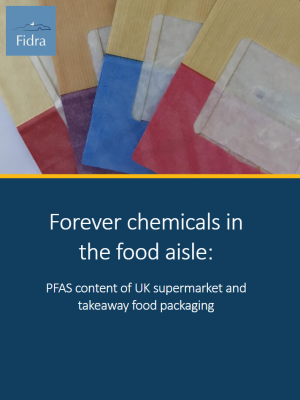Resources for Retailers
PFAS-free Food Packaging Suppliers
Below are a number of food packaging suppliers who offer a wide variety PFAS-free products. Please note that products are not verified by Fidra and verification should be requested from suppliers directly.
If you know of or are a supplier offering PFAS-free products and would like to be added to the list, please get in touch: info@fidra.org.uk
Information sourced either directly from the suppliers or from Clean Production Action.
Resource Library
Below are a number of useful documents for retailers wanting to know more about PFAS in Food Contact Materials (FCMs) and the alternatives currently available.
Forever Chemicals in the Food Aisle
Fidra, 2020
Fidra’s ‘Forever Chemicals in the Food Aisle’ report provides information on the presence of PFAS in disposable paper, board and moulded fibre food packaging across a number of major UK supermarkets and food-to-go outlets. The report also describes the ‘bead test’, now widely used as a preliminary indication of intentionally added PFAS prior to further testing.
Download a copy of the report below, or get in touch at info@fidra.org.uk to find out more or discuss the results further.

How UK Retailers are Tackling Chemicals of Concern
Fidra, 2021
This report summarises retailer progress towards sustainable chemical management utilising examples from two chemical groups of concern, bisphenols and PFAS. Findings are based on retailer engagement during 2020-2021, including an online survey, case studies, and on-going dialogue with retailers.
Poly- and perfluoroalkyl substances (PFAS): sources, pathways and environmental data
Environment Agency, 2021
This report provides an up to date review of our knowledge of PFAS in the UK environment, detailing information and knowledge gaps linked to PFAS production and use in the UK market. It also provides a summary of monitoring programmes and research describing presence of PFAS in the UK environment.
Throwaway Packaging, Forever Chemicals – European-wide survey of PFAS in disposable food packaging and tableware
Collaborative works of Arnika Association (Czech Republic), CHEM Trust, BUND/Friend of the Earth (Germany), Danish Consumer Council (Denmark), The Health and Environment Alliance (HEAL) (Belgium), Tegengif – Erase all Toxins (The Netherlands), Générations Futures (France) and IPEN, 2021
This report is based on a European study looking at the presence of PFAS in disposable paper, board and moulded fibre food packaging items. It aims to understand the widespread use of intentionally added PFAS in food packaging, as well as looking at background contamination levels.
PFAS and alternatives in food packaging (paper and paperboard): Report on the commercial availability and current uses
OECD, 2020
This report outlines availability of current alternatives, both chemical and non-chemical, to PFAS in paper and paperboard food packaging. The work was completed within the framework of the OECD/UNEP Global Perfluorinated Chemicals (PFC) Group.
Risk to human health related to the presence of perfluoroalkyl substances in food
EFSA, 2020
This research article was commissioned by the European Commission and provides the latest scientific opinion of the European Food Safety Authority on the risks PFAS in food pose to human health.
EU Chemicals Strategy for Sustainability
European Commission, 2020
The EU Chemicals Strategy for Sustainability outlines the EU’s latest commitments towards achieving a toxic-free environment. This includes targets towards a clean circular economy, improved transparency of product chemical contents, and swifter action to ban many of the most harmful chemicals in consumer products. The strategy highlights PFAS specifically and commits to future ban on all non-essential uses.
Overview of per-and polyfluoroalkyl substances (PFAS) in the UK
Environment Agency, 2019
This report, obtained via a freedom of information request by Fidra, provides a broad overview of the use and presence of PFAS in the UK, and was developed as a first step to understanding the exposure and effects of PFAS for future risk management. The report includes monitoring data for waste water, surface and ground water, soil, biota and people.
PFAS in paper and board for food contact
Options for risk management of poly- and perfluorinated substances
Nordic Council of Ministers, 2017
This report provides an overview of the use of PFAS in paper and board food contact materials (FCMs), varying toxicities, and migration from FCMs to food. It also assesses whether appropriate risk assessments of fluorinated substances are available, the suitability of current analytical methods, and provides recommendations for the future.

